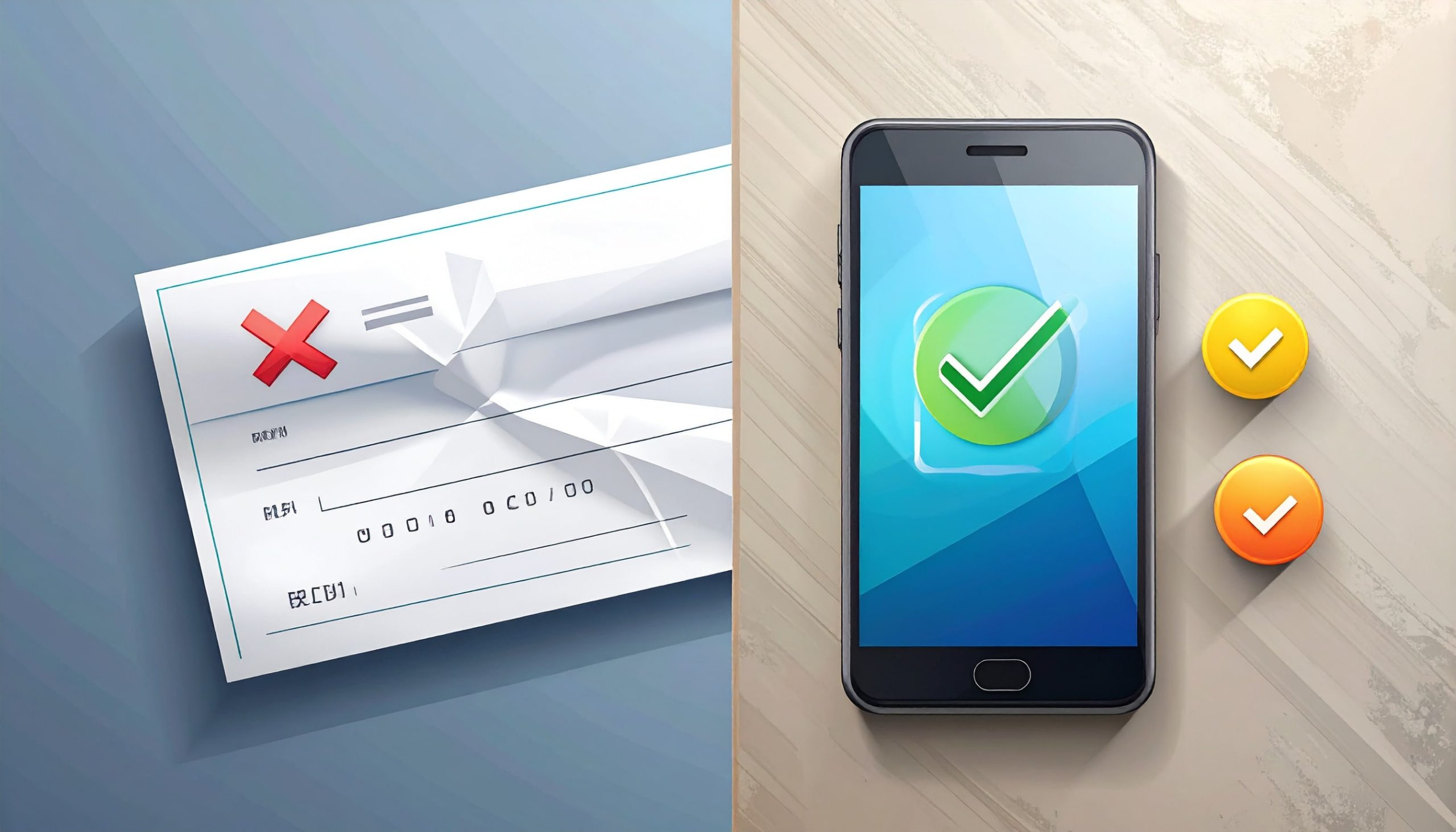The IRS is officially phasing out paper refund checks. Beginning September 30, 2025, taxpayers expecting refunds will no longer receive them by mail unless specific legal exceptions apply. Instead, refunds will generally be delivered electronically, most often via direct deposit.
This change comes as part of Executive Order 14247, signed in March 2025, which directs the modernization of payments to and from government accounts. The order sets aggressive deadlines to eliminate paper-based transactions, reduce fraud, improve efficiency, and speed up access to funds.
But refunds aren’t the only process being modernized. The order also impacts how taxpayers can make payments, with a key cutoff date for enrollment in the IRS’s Electronic Federal Tax Payment System (EFTPS). That deadline—October 17, 2025—is especially important for taxpayers who want the scheduling flexibility and long-term convenience EFTPS provides.
This blog breaks down:
- The background and history behind Executive Order 14247
- The IRS’s adoption timeline and what deadlines matter most
- How the changes affect individuals, businesses, and trusts/estates
- The pitfalls and risks to watch for
- Why this shift is ultimately a positive move
- Recommendations for taxpayers and CPA firms

Background: Executive Order 14247
Signed on March 25, 2025, Executive Order 14247: Modernizing Payments to and From America’s Bank Account requires the federal government to move away from paper-based payments, including checks and money orders. The order cites three core goals:
- Reduce fraud and errors: Paper checks are far more vulnerable to theft, alteration, and misapplication
- Accelerate delivery: Electronic deposits get money into taxpayer accounts in days, not weeks
- Cut costs: Maintaining paper check infrastructure costs hundreds of millions annually
The Treasury Department, including the IRS, has been tasked with implementing the order. Public comment and professional feedback have highlighted challenges—particularly for the unbanked, underbanked, and fiduciary returns like trusts and estates—but the overall trajectory is clear: paper checks are on the way out.
Timing, Transition, and the EFTPS Enrollment Cutoff
The transition is already underway. When the order was signed in March 2025, it created a framework for deadlines that directly affect how taxpayers interact with the IRS.
The most visible change is that, starting September 30, 2025, the IRS will no longer issue paper refund checks by default. Refunds will move to direct deposit or other electronic delivery methods unless restricted by law or special circumstances. For most taxpayers, this means double-checking that their bank account and routing numbers are current and accurate.
But there’s another critical date: October 17, 2025. After this date, individuals will no longer be able to enroll in the EFTPS for the first time. This powerful tool is used for scheduling estimated payments, setting up future-dated payments, and maintaining detailed payment history. Many businesses and practitioners already rely on it, but individuals who haven’t signed up yet will lose the opportunity to do so going forward.
This dual timeline means taxpayers and professionals alike need to act now: confirm electronic refund readiness, and, if EFTPS might be useful in the future, enroll before the cutoff.
Date / Period | What occurs / What must be done | Notes / Caveats |
March 25, 2025 | EO 14247 signed; modernization directive officially adopted | Framework for change begins |
September 30, 2025 | IRS must cease issuing paper refund checks (to the extent allowed by law) | Refunds go electronic unless exceptions apply |
October 17, 2025 | Last date for new individual enrollments in EFTPS | After this, taxpayers must use alternative payment methods if not already enrolled |
Pre-2026 filing season | IRS/Treasury expected to issue detailed guidance and clarify exceptions | Will include rules for trusts, estates, and hardship cases |
How Different Taxpayers are Impacted
Individual Taxpayers
For individuals, the biggest shift is in refunds. If you normally expect a paper check, you’ll need to provide banking details for direct deposit or explore options like prepaid debit cards or digital wallets. Those without access to banking may qualify for exceptions, but the IRS has yet to release full instructions.
Another consideration is payments. If you want the scheduling and record-keeping features of EFTPS, you must enroll before the deadline. After that, options like IRS Direct Pay or debit/credit processors will still be available, but they don’t offer the same flexibility.
Businesses
Most businesses already pay electronically through EFTPS or EFTPS Batch Provider software, so they’re less affected by the enrollment cutoff. But businesses should:
- Confirm their EFTPS accounts are active and credentials current
- Encourage owners or partners who haven’t enrolled individually to do so before the deadline
- Continue discouraging paper check payments to the IRS, which are prone to errors, misapplication, and processing delays
This is also a chance to remind business clients: if they haven’t yet, switch entirely to electronic payment systems for smoother, more reliable compliance.
Trusts and Estates
Trust and estate returns are a gray area. Executors and trustees may not be aware of these changes, and some may not have accounts set up to receive refunds electronically. Guidance is expected before the 2026 filing season, but fiduciaries should prepare now by:
- Confirming bank accounts exist for refund deposits
- Understanding whether beneficiaries or trustees may need to supply additional information
- Considering EFTPS enrollment before October 17 if electronic payments will be required
What to Watch for: Pitfalls and Risks
Electronic payments are designed to cut down on lost or uncashed refunds. That said, they’re not without their own challenges. If a taxpayer enters incorrect banking details, refunds can be delayed or even misdirected. This makes accuracy more important than ever. For those who are unbanked or underbanked, electronic-only refunds create a real obstacle. While hardship exemptions are expected, this isn’t something to leave to chance. Action will be needed to ensure those taxpayers receive the refunds they’re entitled to.
The looming October 17, 2025 EFTPS enrollment cutoff adds another wrinkle. New businesses or individuals who may want to use EFTPS in the future must sign up before this deadline. Miss it, and the opportunity is gone permanently. While other payment methods remain available, they don’t offer EFTPS’s scheduling flexibility or detailed record keeping, which many businesses and professionals rely on.
One of the biggest reasons the IRS is making this shift is to reduce the number of lost or misapplied payments. Paper checks have long been a weak point. They rely not only on the taxpayer’s ability to receive and deposit the check but also on the postal system to deliver it on time and to the right place. Anyone who’s moved mid-year due to a job change, marriage, or divorce knows the headaches that come from missing or delayed mail. Electronic deposits help eliminate that risk.
For fiduciaries, trusts, and estates, the risks look a little different. Since the IRS hasn’t yet provided detailed guidance on how refunds will be processed electronically for these entities, there’s potential for bottlenecks. Trustees and executors should keep a close eye on IRS updates so they can act quickly when final rules are published. Proactive planning now will save confusion later.
Why this Change is a Good Thing
At first glance, eliminating paper refund checks may feel like one more hassle from the IRS. But when you step back, the benefits are clear.
Security
Paper checks include all the information someone would need to pull funds from a bank account. Sending that information through the mail is risky. If a check gets intercepted, opened, or stolen, the taxpayer could face fraud issues that take weeks or months to unwind. While banks do have protections in place, the hassle and stress aren’t worth it. Electronic deposits dramatically reduce these risks, offering stronger protections for taxpayers and the government alike.
Speed
Paper checks need to be printed, mailed, and delivered, which takes time and is subject to postal delays. Severe weather, address changes, or simple human error can all disrupt delivery. With electronic payments, funds are processed and transmitted far faster. Most taxpayers would prefer to see their money in a matter of days, not weeks.
Cost Savings
Maintaining the infrastructure to print, secure, and deliver millions of checks each year costs the federal government hundreds of millions of dollars. By going digital, the IRS reduces its overhead. Less government overhead means fewer tax dollars spent on outdated systems. Even if most of us don’t love the idea of funding the IRS, saving money while delivering refunds faster is a win-win.
Modernization
The world has already gone digital. Paychecks are deposited electronically, and people use ACH transfers, Venmo, PayPal, Apple/Google Pay, and more every day. Paper checks are becoming the exception, not the norm. This change brings the IRS into alignment with how individuals and businesses already transact in the real world.
Recommendations and Next Steps
This change is coming whether you like it or not. So the real question is: what should you do to get ready for it?
Make sure you’re ready for digital refunds
This means confirming your bank account and routing numbers are accurate and on file with your tax preparer. If you haven’t used direct deposit for refunds in the past, now is the time to get set up.
Enroll in EFTPS before October 17, 2025
If you want access, this is the final chance to get into the system, and once the window closes, there’s no going back. We don’t know if or when EFTPS itself might be phased out entirely, but if you value the ability to schedule payments and maintain detailed payment records, you need to be in the system before the deadline.
Switch away from paper checks for payments
Whether you use IRS Direct Pay, EFTPS (if enrolled), or debit/credit card options, paying electronically is safer, quicker, and far less likely to be misapplied. Electronic payments also tie directly to your Social Security number or EIN at the time of deposit, which cuts down on processing errors. Paper checks, by contrast, require manual handling and are more prone to mistakes.
Prepare now to avoid issues later
For trustees and fiduciaries, now is the time to prepare. Make sure bank accounts are in place to receive electronic refunds and stay alert for IRS guidance. Being proactive will help you avoid delays and complications when the new rules take effect.
The bottom line: electronic refunds and payments are becoming the new normal. By taking a few simple steps now, taxpayers, businesses, and fiduciaries can make the transition smooth and avoid unnecessary headaches later.
